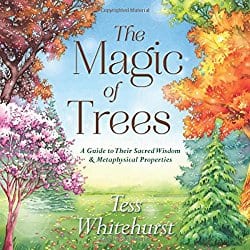
 The Magic of Trees: A Guide to Their Sacred Wisdom & Metaphysical Properties, by Tess Whitehurst
The Magic of Trees: A Guide to Their Sacred Wisdom & Metaphysical Properties, by Tess Whitehurst
Llewellyn Publications, 978-0-7387-4803-0, 374 pp., 2017
When I explain to non-Pagans what draws me to the Pagan path, I start with its celebration of diversity in nature — often citing the myriad of flowers and trees found all over the world, each with their gifts of beauty and utility. Some feed us or other animals or insects, some give us medicine, some are poisonous but enchant us with their form. And each holds wisdom if we open our third eye to connect with it. In The Magic of Trees, Tess Whitehurst has provided “a guide to their sacred wisdom and metaphysical properties,” one that we can use to begin exploring their mundane and spiritual gifts.
The book begins with an orientation section, describing methods of tree magick and notes on gathering and correspondences. The bulk of the book discusses the trees — some common, some less so — followed by three appendices for magical uses, elemental correspondences, and planetary correspondences. Finally, there is a copious bibliography. Whitehurst writes, “I brainstormed and scoured gardening and tree reference books and websites, compiling as comprehensive a list as I possibly could before beginning.”1 She did an excellent job.
Each tree entry begins with a short introduction, including the scientific name of the tree, and which variety is being discussed (if it’s found in different regions of the world). That is followed by the tree’s magical uses and next, its magical correspondences — element, gender, and planet — which were ascertained by dowsing with a pendulum. For some trees, charms, potions, spells, recipes, or rituals are included.
For instance, the entry for cedar contains all of these elements. Whitehurst explains that cedar is “considered to be profoundly sacred since time immemorial, in ancient spiritual literature — time and time again — cedar is aligned with divinity and divine wisdom.”2 She then defines its magical uses: breaking spells, clarity and focus, sacred space, strengthening the energy field, and wisdom. Its magical correspondences are to the element Air, the gender Masculine, and the planet Sun. And for that certain spell you desperately wish you could unwind (we’ve all done ’em) the entry includes a “Cedar Extra-Strength Spell-Breaking Ritual.”3
The author includes a lot of information for each entry, and in some cases I wished for more, in the form of a footnote stating where in her copious bibliography she had found it. In a few entries she states the name of the source for a particular magical use, but these were few and far between. Source citations would have been particularly useful in the entries for the lesser-known trees.
However, Whitehurst does a fine job of distilling the information she’s found and proves that tree magick is incredibly diverse. Along with the more usual reasons we invoke magic, such as those for cedar, some trees can help you with attracting or blessing bees (chaste tree and redbud), broom making (ash), aiding digestion (cinchona and mesquite), hair growth (avocado), making music (elder and jacaranda), and alignment with unicorns (apple).
And why shouldn’t tree magick be accessed for any possible need? “Truly, if any single thing should be sacred to humans, it’s trees,” Whitehurst says. “Even today trees form the framework of our very lives.”4 Our homes can be built of and furnished with wood, she explains, we use paper made from wood, we eat fruits and nuts grown on trees, much of our medicine is derived from trees, and the most important discovery humankind has ever made — fire — was possible only because of trees. Our magical workings can only benefit from a closer relationship with these ancient, wise beings, and The Magic of Trees suggests ample ways to begin.









